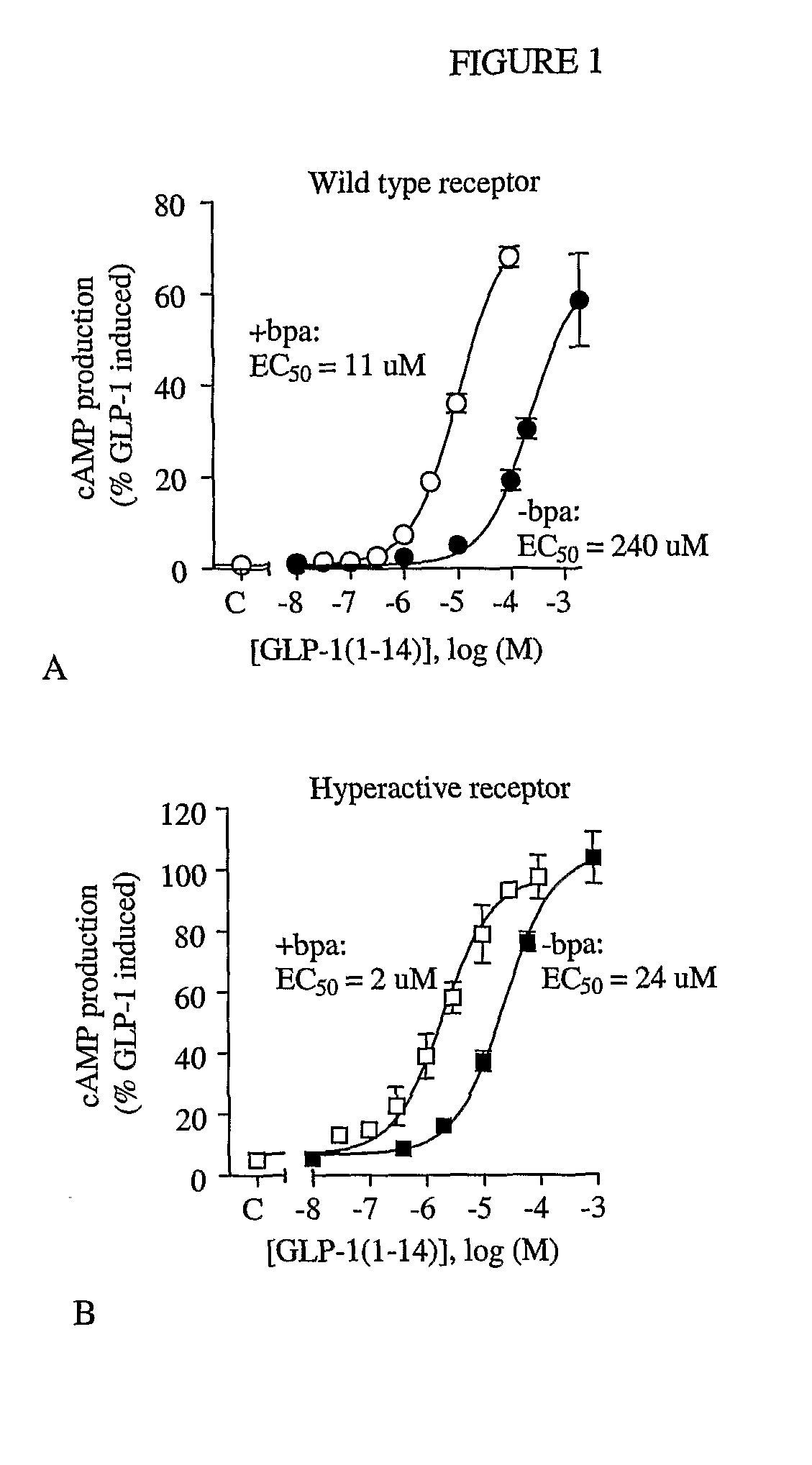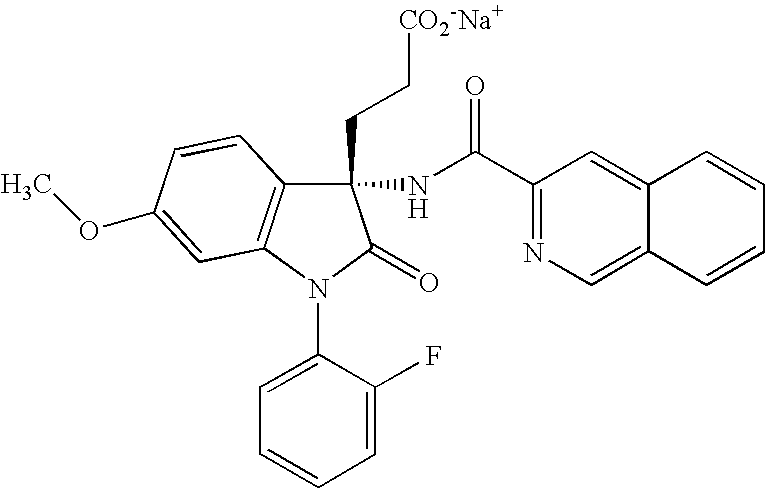Fragments of the Glucagon-Like Peptide-1 and Uses Thereof
a glucagon-like, fragment-like technology, applied in the field of peptide fragments and derivatives, can solve the problems of excessive blood glucose reduction, kidney failure, blindness, loss of limbs,
- Summary
- Abstract
- Description
- Claims
- Application Information
AI Technical Summary
Benefits of technology
Problems solved by technology
Method used
Image
Examples
example 1
In Vitro Assay of GLP-1 Receptor Stimulation by GLP-1 (7-20) and a GLP-1 (7-20) Synthetic Derivative to GLP-1 Receptor in COS Cells
[0136]COS-7 cells were transiently transfected with cDNA encoding the wild-type human GLP-1 receptor. Peptide induced cAMP production was measured by radioimmunoassay. A 14-amino acid fragment, GLP-1 (7-20) [which as mentioned previously is the same as GLP-1 (1-14)]amide (in FIG. 1A, represented with closed circles and “−bpa”) stimulated cAMP production with a half maximal excitatory concentration (EC50) of 240 μM. Carboxy-terminal tethering of a small molecule, biphenylalanine (in FIG. 1A, represented with open circles and “+bpa”) led to a 22-fold potency increase, ie. EC50 of 11 μM. The data shown in FIG. 1A represent the mean±SEM of at least three experiments. This shows that GLP-1 (7-20) amide specifically interacts with the GLP-1 receptor and is able to activate cAMP production through the receptor. It also shows that the derivatization of GLP-1 (7-...
example 2
Preclinical Trial Protocol for GLP-1 (7-20)
[0139]In this example, qualified animal models for diabetes are employed to examine the dose ranges of GLP-1 (7-20).
[0140]Treatment with GLP-1 (7-20) Animal Model. Zucker diabetic fatty (ZDF) rats are a well characterized type 2 diabetes animal model. (Suh Y H, et al. J Mol. Endocrinol. 2005 April; 34(2):299-315.)
[0141]Procedure: In a parental colony of ZDF rats, each rat receives dosages of GLP-1(7-20) and is compared to ZDF rats who does not receive GLP-1 (7-20) amide. Doses of GLP-1 (7-20) range from 1 μg / kg / day to 100 mg / kg / day.
[0142]Treatment. Cohorts are treated in 2 arms with 2-4 dose ranges of GLP-1 (7-20) amide and a placebo, at a compensated dose for animal size, metabolism and circulation. Arm 1: saline, Arm 2: GLP-1 (7-20) amide.
[0143]Study Assessment. Blood glucose levels are measured every week with a One Touch II glucose meter (Lifescan). Blood insulin levels are also measured. Rats are considered diabetic after 2 consecutive...
example 3
Preclinical Trial Protocol for GLP-1 (7-20)−bpa and GLP-1 (7-20)+bpa
[0145]In this example, qualified animal models for diabetes are employed to examine the dose ranges of GLP-1 (7-20)−bpa and GLP-1 (7-20)+bpa.
[0146]Treatment with GLP-1 (7-20)−bpa and GLP-1 (7-20)+bpa Animal Model. Zucker diabetic fatty (ZDF) rats are a well characterized type 2 diabetes animal model. (Suh Y H, et al. J Mol. Endocrinol. 2005 April; 34(2):299-315.)
[0147]Procedure: In a parental colony of ZDF rats, each animal receives dosages of GLP(7-20)−bpa and / or GLP(7-20)+bpa and are compared to ZDF rats who receive neither. Doses of GLP(7-20)−bpa and GLP(7-20)+bpa range from 1 μg / kg / day to 100 mg / kg / day.
[0148]Treatment. Cohorts are treated in 4 arms with 24 dose ranges of each drug and a placebo, at a compensated dose for animal size, metabolism and circulation. Arm 1: saline, Arm 2: GLP(7-20)−bpa; Arm 3: GLP(7-20)+bpa; Arm 4: GLP(7-20)−bpa plus GLP(7-20)+bpa.
[0149]Study Assessment. Blood glucose levels are measu...
PUM
| Property | Measurement | Unit |
|---|---|---|
| length | aaaaa | aaaaa |
| weight loss | aaaaa | aaaaa |
| weight | aaaaa | aaaaa |
Abstract
Description
Claims
Application Information
 Login to View More
Login to View More - R&D
- Intellectual Property
- Life Sciences
- Materials
- Tech Scout
- Unparalleled Data Quality
- Higher Quality Content
- 60% Fewer Hallucinations
Browse by: Latest US Patents, China's latest patents, Technical Efficacy Thesaurus, Application Domain, Technology Topic, Popular Technical Reports.
© 2025 PatSnap. All rights reserved.Legal|Privacy policy|Modern Slavery Act Transparency Statement|Sitemap|About US| Contact US: help@patsnap.com



